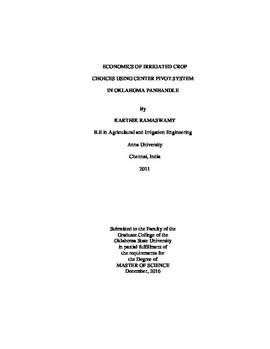| dc.contributor.advisor | Stoecker, Arthur L. | |
| dc.contributor.author | Ramaswamy, Karthik | |
| dc.date.accessioned | 2018-06-29T14:41:06Z | |
| dc.date.available | 2018-06-29T14:41:06Z | |
| dc.date.issued | 2016-12-01 | |
| dc.identifier.uri | https://hdl.handle.net/11244/300367 | |
| dc.description.abstract | The study seeks to maximize the net benefits through extraction of groundwater from Ogallala aquifer in the Oklahoma Panhandle. In recent decades in most parts of the southern Great Plains overlying Ogallala, the water table level decline has been significant. The continuous decline of the Ogallala water table results in reduced well capacity, increased pumping cost, and reduced crop yields. Producers with limited well capacity will choose to irrigate fewer acres, implement dry land practices, apply less water to existing acres, or choose an alternative crop that requires less water. As the present-day pumping rate declines, the producer can make choices to irrigate corn or grain sorghum that will derive maximum net benefit. Research in the Oklahoma Panhandle has shown 150 bushels of grain sorghum [Sorghum bicolor (L.) Moench] can be produced with 9.4 inches of irrigation, while 22 inches are required to produce 190 bushels of corn [Zea mays L.]. Corn has higher profits over variable cost per irrigated acre. However, grain sorghum provides higher returns per acre-foot of water. ‘EPIC’ was used to simulate crop yields for corn and grain sorghum corresponding to 120-acre pivot circles with various well capacities under irrigation stress triggers between 30 and 90 percent of soil moisture. The well capacity and number of acres determined the frequency between irrigations. Pumping cost for well operations and water supply during well capacity transitions were determined using Cooper-Jacob well drawdown calculations. Expected water use, present value of crop production, capital investment of the irrigation system, land constraint and water supply for each annual combination were then incorporated into a 50-year (CPLEX) Mixed Integer Linear Programming (MIP) model to obtain long term profit maximizing benefits. To compare the long-term results with short-term profit maximization, a simple recursive optimization was developed to determine the series of annual profits that will give the maximum Net Present Value (NPV) over the pivot purchases. The results show that Long-Term Profit Maximizing (LTPM) producer with high saturated sand makes greater profits than the Annual Profit Maximizing (APM) producer. However, with shorter saturated sand results do not show difference in their overall benefits between APM and LTPM. | |
| dc.format | application/pdf | |
| dc.language | en_US | |
| dc.rights | Copyright is held by the author who has granted the Oklahoma State University Library the non-exclusive right to share this material in its institutional repository. Contact Digital Library Services at lib-dls@okstate.edu or 405-744-9161 for the permission policy on the use, reproduction or distribution of this material. | |
| dc.title | Economics of Irrigated Crop Choices Using Center Pivot System in Oklahoma Panhandle | |
| dc.contributor.committeeMember | Warren, Jason G. | |
| dc.contributor.committeeMember | Vitale, Jeffrey D. | |
| dc.contributor.committeeMember | Jones, Rodney D. | |
| dc.contributor.committeeMember | Taghvaeian, Saleh | |
| osu.filename | Ramaswamy_okstate_0664M_14849.pdf | |
| osu.accesstype | Open Access | |
| dc.description.department | Agricultural Economics | |
| dc.type.genre | Thesis | |
| dc.type.material | text | |
